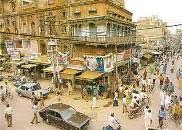
Rawalpindi, also known as Pindi, has a long history spread over several millennia. Archaeologists believe that a distinct culture flourished on this plateau as far back as 3000 years. The material remains found at the site prove the existence of a Buddhist establishment contemporary to Taxila
Taxila
Taxila is an important archaeological site in the Punjab province of Pakistan. It dates back to the Ancient Indian period and contains the ruins of the Gandhara city of Takshashila an important Vedanta/Hinduism and Buddhist centre of learning from the 6th century BCE...
and of a Vedic civilisation. The nearby town of Taxila has another significance; according to the Guinness Book of World Records it has the world's oldest university - Takshashila University.
Sir Alexander Cunningham
Alexander Cunningham
Sir Alexander Cunningham was a United Kingdom archaeologist and army engineer, known as the father of the Archaeological Survey of India. Both his brothers, Francis Cunningham and Joseph Cunningham became well-known for their work in British India....
identified certain ruins on the site of the cantonment with the ancient city of Gajipur or Gajnipur, the capital of the Bhatti tribe in the ages preceding the Christian era. Graeco-Bactrian coins, together with ancient bricks, occur over an area of 500 ha
Hectare
A hectare is a unit of area equal to , or one square hectometre , and commonly used for surveying.The hectare is used in most countries around the world, especially in domains concerned with land ownership, land planning, and land management, including law , agriculture, forestry, and town planning....
(2 mi²). Known within historical times as Fatehpur Baori, Rawalpindi fell into decay during one of the Mongol invasions in the fourteenth century.
It appears that the ancient city went into oblivion as a result of the White Hun devastation. The first Muslim
Muslim
:A Muslim , , is an adherent of the religion of Islam. The feminine form is Muslimah . Literally, the word means "one who submits "....
invader, Mahmud of Ghazni
Mahmud of Ghazni
'Mahmud of Ghazni Province' , also known as , was the founder of the Ghaznavid Empire, which he ruled from 997 until his death. Mahmud turned the former provincial city of Ghazni into the wealthy capital of an extensive empire which extended from Afghanistan into most of Iran as well as Pakistan and regions of North-West India....
979-1030), gave the ruined city to a Gakhar
Gakhars
File:Hazara.gifThe Gakhars were a fiercely independent and warlike clan now located in Rawalpindi, Islamabad, Jhelum District, Kashmir, Gilgit Valley, Baltistan, Chitral, Khanpur and Mirpur, Pakistan regions in modern day Pakistan....
Chief, Kai Gohar. The town, however, being on an invasion route, could not prosper and remained deserted until Jhanda Khan, another Gakhar
Gakhars
File:Hazara.gifThe Gakhars were a fiercely independent and warlike clan now located in Rawalpindi, Islamabad, Jhelum District, Kashmir, Gilgit Valley, Baltistan, Chitral, Khanpur and Mirpur, Pakistan regions in modern day Pakistan....
Chief, restored it and named it Rawalpindi after the village Rawal in 1493. Rawalpindi remained under the rule of the Gakkhars until Muqarrab Khan, the last Gakkhar ruler, was defeated by the Sikh
Sikh
Sikh is the title and name given to an adherent of Sikhism. The term has its origin in the Sanskrit ' "disciple, learner" or ' "instruction"....
s under Sardar Milka Singh in 1765. Singh invited traders from the neighbouring commercial centres of Jhelum and Shahpur to settle in the territory.
Early in the nineteenth century Rawalpindi became for a time the refuge of Shah Shuja
Shuja Shah Durrani
Shuja Shah Durrani was ruler of the Durrani Empire from 1803 to 1809. He then ruled from 1839 until his death in 1842. Shuja Shah was of the Sadozai line of the Abdali group of Pashtun people....
, the exiled king of Afghanistan, and of his brother Shah Zaman. The present native infantry lines mark the site of a battle fought by the Gakhars under their famous chief Sultan Mukarrab Khan in the middle of the eighteenth century. Rawalpindi was taken by Sikh ruler Maharaja Ranjit Singh
Maharaja Ranjit Singh
Maharaja Ranjit Singh may refer to:*Maharaja Ranjit Singh, a ruler of Punjab*Maharaja Ranjit Singh, Bharatpur, the Jat ruler of the Bharatpur princely state in Rajasthan, India...
in 1818. It was at Rawalpindi, on March 14, 1849, that the Sikh army under Chattar Singh and Sher Singh finally laid down their arms after the battle of Gujrat and were decisively defeated.



